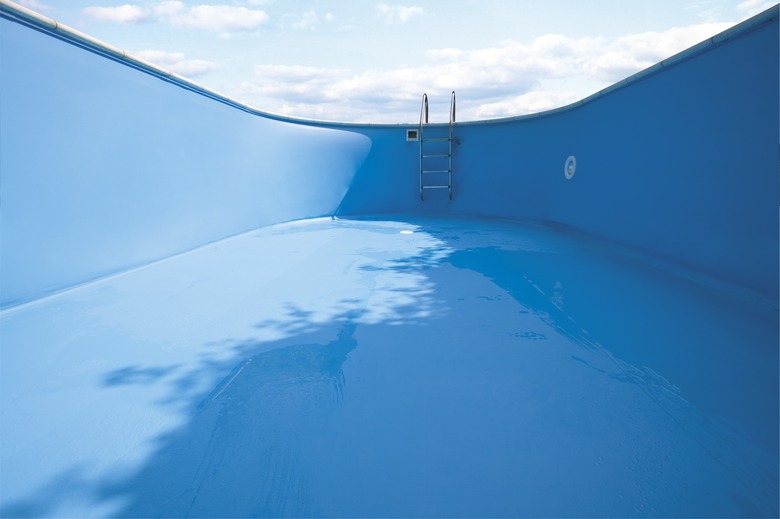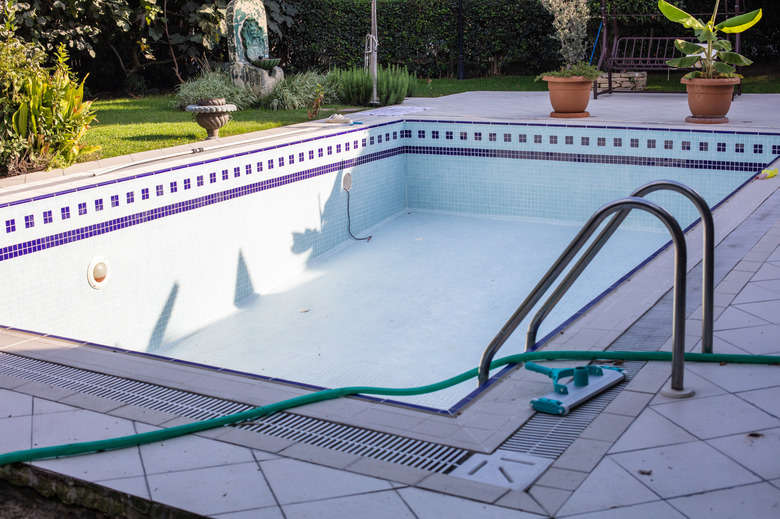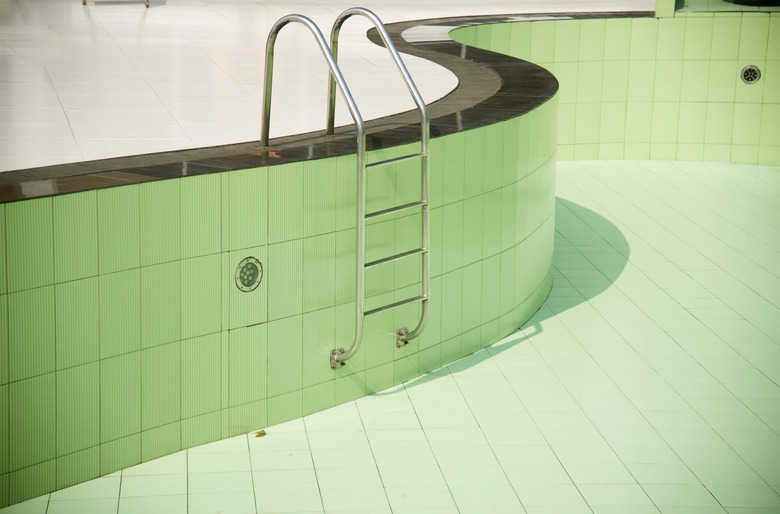What To Know Before You Fill In A Swimming Pool
We may receive a commission on purchases made from links.
You might think it's a relatively easy matter to fill in an in-ground swimming pool that you no longer want. After all, isn't it just a matter of filling it in with dirt, smoothing it over and overplanting with grass? Unfortunately, it's nowhere near that simple, and despite what you might think, it's almost never a DIY project.
Reasons for Filling In a Pool
Reasons for Filling In a Pool
Swimming pools are one of those amenities for which everyone longs — at least until you've spent a few years maintaining and repairing one. In fact, to demolish and fill in a swimming pool is almost as common as building a new one, and an entire business sector exists to help homeowners get rid of swimming pools. There are many reasons you might choose to eliminate your pool.
- Pools are expensive to operate. Depending on where you live, it can cost $100 to $600 per month just to heat the pool. If you hire a pool service to perform the weekly and monthly maintenance chores, the cost is even higher. And don't forget the cost of unavoidable repairs.
- Pools are water-wasters. Unless you diligently cover the pool after every use, it will inevitably waste a lot of water through evaporation alone. It's estimated that 25,000 to 50,000 gallons of water per year evaporate from the average pool. It can be even more in very sunny or windy climates.
- Pools are dangerous. In a home (or neighborhood) with small children, constant vigilance is required to avoid tragedy. Most communities require protective fencing around your pool, which is one more expense. Some homeowners find that owning a pool causes constant nervousness, and they're quite relieved once it's gone.
- Pools affect real estate value. Some potential buyers are attracted to a home with a well-maintained pool, but you'll actually have a larger group of prospective buyers if you don't have a pool at all. This is especially true in the low and midlevel real estate market, where lots of people are put off by the costs, hassle and hazards of owning a pool. In the luxury real estate market, however, a pool is usually an advantage when it comes to selling but only if the pool is in good condition.
- Pools take up a lot of space. Even a very small 12 x 20-foot pool occupies 240 square feet of landscape space and considerably more if there is a concrete apron around the pool. You may well want this landscape space for other forms of outdoor recreation or to make room for that big new garage of which you've been dreaming.
- Pools are a lot of work. Keeping a pool safe and healthy means daily, weekly, monthly and annual maintenance chores: testing the water, adjusting the chemistry, cleaning filters, vacuuming the pool, winterizing, repairing, etc. No wonder so many homeowners grow weary of the labor and choose to fill in the pool.
Partial Demo and Fill-In Approach
Partial Demo and Fill-In Approach
There are a number of options when it comes to filling in your swimming pool. How you approach it depends on local regulations as well as your future plans for the yard area.
You may be able to get by with a partial demolition and fill-in approach. This is the least expensive option by thousands of dollars, but some communities have building codes that don't allow it, and this approach limits how you can use the site in the future.
After a partial removal and fill in, you'll be limited to using it for landscaping — either planting lawn grass, trees or shrubs — or possibly using the area to build a patio, deck, gazebo or other similar structure. You won't, however, be able to build a room addition, garage or other permanent structure with a foundation on the site where the pool once existed. A filled-in pool area is simply not stable enough to bear the weight and stress of a permanent structure.
If you opt for partial demolition and fill in, the process begins with draining the pool completely and disconnecting any utility services that are present, such as electrical service or gas lines for heaters. These are activities that will probably require professionals. Large holes (at least 20) are then punched in the bottom of the pool to ensure that rainwater can drain through. A professional demolition company will probably do this work with a large earthmoving machine fitted with a jackhammer or wrecking ball. It's not enough to punch a few small holes in the bottom of the pool using a rented jackhammer, as the holes need to be large and plentiful to ensure good drainage.
Next, the top 18 to 36 inches of the pool rim are broken up with the concrete rubble used to fill in the bottom of the empty pool. If you have a fiberglass or vinyl pool rather than concrete, the top edges are cut away or dismantled and removed, including any metal framework beneath the liner.
The remaining pool cavity is then filled in with a mixture of gravel, sand and soil. The material used for the fill will depend on the soil composition in your yard. The goal is to make it consistent with the surrounding soil in your yard.
The contractor will likely compress the fill material with a plate compactor at several stages as the fill-in process progresses to make sure the area is stable and solid. Good-quality topsoil is then spread over the top of the excavation and smoothed over to blend in with the rest of the yard. After this, the area is ready for planting lawn grass or other plants or, where allowed by code, for constructing a shed, patio or deck.
Complete Demolition and Removal
Complete Demolition and Removal
The process becomes considerably more involved and more expensive if you want the option to build a permanent structure on the site. For code purposes, a permanent structure is usually defined as one that uses in-ground concrete footings or one that is permanently anchored to the house itself. This includes structures like garages, room additions or an attached deck or sunporch.
For complete demolition and removal of the pool, the process again starts with draining the water and disconnecting utilities. With a concrete pool, the entire concrete shell is then broken up into manageable pieces and hauled away — a job that's almost impossible without large earthmoving equipment. For pools made from materials other than concrete, the entire shell and any framework materials are cut into pieces and hauled away.
You then backfill the hole with gravel, sand and fill soil, periodically compacted to ensure it is stable. The last several inches are covered with topsoil to make the site suitable for growing grass or other plants.
Considerations for Engineering
Considerations for Engineering
In some communities, building a permanent structure on the site where a pool was once located is strictly regulated to the point where it is sometimes not allowed at all. More often, though, it's possible to return the site to a condition amenable to new permanent construction but only if the work is done under the supervision of a landscape engineer. The engineer is often present at key moments during the work and will likely conduct tests to ensure the filled-in area is firmly compacted and stable. The engineer will perform density testing and will certify via a final engineering review that the area is buildable.
A pool that has been improperly demolished is a very serious liability. If heavy rain saturates the soil and the pool shell has not been properly broken up, the result can be swampy morass. Any kind of permanent structure built on such a site is doomed to failure.
For this reason, you're required by law to disclose the fact that your pool was filled in when it comes time to sell your home. Keep copies of your final engineering review as well as detailed information on how your contractor did the work. If done correctly, a filled-in pool is no hindrance to selling, and it may even be an advantage. However, you can expect problems if the job was done contrary to accepted practice.
Pool Removal Costs
Pool Removal Costs
According to Home Advisor, the cost for professional removal of an in-ground pool averages about $5,000 for a partial demo/fill-in approach and runs $9,000 to $19,000 for complete demolition and removal. This may seem like a lot, but it's much more cost-effective than the $30,000 that it can cost to repair a badly degraded pool. Your removal cost may be equaled by the money you save on routine maintenance and upkeep. You may well find that banishing a bad pool adds more in real estate equity than the cost of the demolition. A home with no pool at all is worth more than one with a failing pool.
Avoid the temptation to save money by hiring a landscape contractor who wants to simply back up a truck and dump soil into the pool to hide it from view. A good contractor will have specialized techniques and machinery for demolition, will be able to speak to you convincingly about the process, will work in consultation with an engineer and can show you detailed photos of how the workers will proceed.
References
- HomeAdvisor: How Much Does It Cost To Remove & Fill In A Swimming Pool?
- Hometown Demolition: The Homeowner's Guide to Swimming Pool Demolition and Removal
- Sterling Pool Service: An Overview of the Pool Demolition and Filling Process
- Realtor.com: 6 Reasons to Demolish Your Swimming Pool Before Summer


